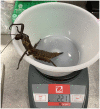Development and Evaluation of a Serum Transfusion Process in the Thorny Devil Stick Insect (Eurycantha calcarata)
- PMID: 35445103
- PMCID: PMC9015650
- DOI: 10.3389/fvets.2022.847043
Development and Evaluation of a Serum Transfusion Process in the Thorny Devil Stick Insect (Eurycantha calcarata)
Abstract
The thorny devil stick insect (Eurycantha calcarata) is a common invertebrate maintained under human care. Blood (hemolymph) transfusions are a widely used therapeutic tool in other species, but investigation in terrestrial arthropods remains scarce. Study objectives were development and evaluation of a serum transfusion process in the thorny devil stick insect. Twenty-five clinically healthy adult insects (9.9-23.0 g) were enrolled and baseline body weights were collected. Hemolymph collection was not successful in males, thus, all were recipient only (n = 12, MR). Females were divided into donor (n = 4, FD) or donor and recipient (n = 9, FDR) groups. Females were manually restrained and up to 1 mL of hemolymph was collected from the abdominal segment caudal to the proximal hindlimb using an 18 g hypodermic needle and passive collection via gravity. Hemolymph was quantified, centrifuged, and the serum separated. Insects were then injected superficially at the lateral aspect of the abdomen with 0.01 mL/g FD serum (MR), lactated Ringer's solution (LRS) equal to collected hemolymph volume (FD), or a combination of FDR serum and LRS equal to collected hemolymph volume (FDR). Response to stimulation, surface temperature, and righting reflex and mortality were serially assessed for up to 24 h and 7 days, respectively, following injection. In FD, median (range) injected LRS dose was 0.04 (0.03-0.06) mL/g. In FDR, median (range) injected serum, LRS, and combined serum and LRS dose was 0.03 (0.02-0.04), 0.01 (0-0.04), and 0.04 (0.02-0.06) mL/g, respectively. A mild temperature increase (maximum +2.9°C) (MR n = 10, FD n = 3, FDR n = 8) and delayed righting reflex (MR n = 4, FD n = 3, FDR n = 7) occurred in a subset of insects following injection. Two deaths occurred at 2 min (n = 1, FDR) and 96 h (n = 1, FD) post-injection. This is the first report of serum transfusions in thorny devil stick insects, and while largely successful, minor to severe transfusion reactions may occur.
Keywords: Eurycantha calcarata; serum; stick insect; transfusion; transfusion reaction.
Copyright © 2022 Gregory, Heniff, Gorges, Lathan, Lewbart and Balko.
Conflict of interest statement
The authors declare that the research was conducted in the absence of any commercial or financial relationships that could be construed as a potential conflict of interest.
Figures
References
-
- Bradler S, Buckley TR. Biodiversity of phasmatodea. In: Fottit RG, Adler PH, editors. Insect Biodiversity Science and Society, Volume 2. Hoboken, NJ: John Wiley and Sons, Ltd. (2018). p. 281–313. 10.1002/9781118945582.ch11 - DOI
-
- Cooper JE, Pellett S, O'Brien M. Insects. In: Lewbart GA, editor. Invertebrate Medicine. Oxford: John Wiley and Sons, Ltd. (2022). p. 413–37. 10.1002/9781119569831.ch18 - DOI
-
- Eilenberg J, Jensen AB. Prevention and management of diseases in terrestrial invertebrates. In: Hajek AE, Shapiro-Ilan DI, editors. Ecology of Invertebrate Diseases, 1st Edn. Hoboken, NJ: John Wiley and Sons, Ltd. (2018). p. 495–526. 10.1002/9781119256106.ch14 - DOI
-
- Lewbart GA. Introduction. In: Lewbart GA, editor. Invertebrate Medicine, 3rd Edn. Oxford: John Wiley and Sons, Ltd. (2022). p. 1–6. 10.1002/9781119569831.ch1 - DOI
LinkOut - more resources
Full Text Sources


